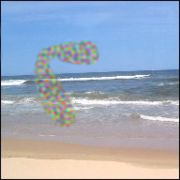Aura (symptom)
| Aura | |
|---|---|
 | |
| Artist's depiction of zig-zag lines experienced as part of a migraine aura phenomenon | |
| Specialty | Neurology, neuro-ophthalmology |
| Types | Scintillating scotoma |
| Differential diagnosis | Persistent aura without infarction, retinal migraine, visual snow |
An aura is a perceptual disturbance experienced by some with epilepsy or migraine. An epileptic aura is actually a minor seizure.[1]
Epileptic and migraine auras are due to the involvement of specific areas of the brain, which are those that determine the symptoms of the aura. Therefore, if the visual area is affected, the aura will consist of visual symptoms, while if a sensory one, then sensory symptoms will occur.
Epileptic auras are subjective sensory or psychic phenomena due to a focal seizure, i.e. a seizure that originates from that area of the brain responsible for the function which then expresses itself with the symptoms of the aura. It is important because it makes it clear where the alteration causing the seizure is located. An epileptic aura is in most cases followed by other manifestations of a seizure, for example a convulsion, since the epileptic discharge spreads to other parts of the brain. Rarely it remains isolated. Auras, when they occur, allow some people who have epilepsy time to prevent injury to themselves and/or others when they lose consciousness.
Migraine
[edit]The aura of migraine is visual in the vast majority of cases, because dysfunction starts from the visual cortex. The aura is usually followed, after a time varying from minutes to an hour, by the migraine headache. However, the migraine aura can manifest itself in isolation, that is, without being followed by headache. The aura can stay for the duration of the migraine; depending on the type of aura, it can leave the person disoriented and confused. It is common for people with migraines to experience more than one type of aura during the migraine. Some people who have auras have the same type of aura every time.
Auras can also be confused with sudden onset of panic, panic attacks or anxiety attacks, which creates difficulties in diagnosis. The differential diagnosis of patients who experience symptoms of paresthesias, derealization, dizziness, chest pain, tremors, and palpitations can be quite challenging.[2]
Seizures
[edit]An epileptic aura is the consequence of the activation of functional cortex by abnormal neuronal discharge.[3] In addition to being a warning sign for an impending seizure, the nature of an aura can give insight into the localization and lateralization of the seizure or migraine.[4][5]
The most common auras include motor, somatosensory, visual, and auditory symptoms.[6] The activation in the brain during an aura can spread through multiple regions continuously or discontinuously, on the same side or to both sides.[7]
Auras are particularly common in focal seizures. If the motor cortex is involved in the overstimulation of neurons, motor auras can result. Likewise, somatosensory auras (such as tingling, numbness, and pain) can result if the somatosensory cortex is involved. When the primary somatosensory cortex is activated, more discrete parts on the opposite side of the body and the secondary somatosensory areas result in symptoms ipsilateral to the seizure focus.[8][9]
Visual auras can be simple or complex. Simple visual symptoms can include static, flashing, or moving lights/shapes/colors caused mostly by abnormal activity in the primary visual cortex. Complex visual auras can include people, scenes, and objects which results from stimulation of the temporo-occipital junction and is lateralized to one hemifield. Auditory auras can also be simple (ringing, buzzing) or complex (voices, music). Simple symptoms can occur from activation in the primary auditory cortex and complex symptoms from the temporo-occipital cortex at the location of the auditory association areas.[10]
Examples
[edit]


An aura sensation can include one or a combination of the following:
Visual changes
[edit]- Bright lights and blobs[11]
- Zigzag lines[12]
- Distortions in the size or shape of objects[13]
- Vibrating visual field
- Scintillating scotoma
- Shimmering, pulsating patches, often curved
- Tunnel vision
- Scotoma[14]
- Blind or dark spots
- Curtain like effect over one eye
- Slowly spreading spots
- Kaleidoscope effects
- Temporary blindness in one or both eyes[15]
- Heightened sensitivity to light[16]
Auditory changes
[edit]- Hearing voices or sounds that do not exist: auditory hallucinations[17]
- Modification of voices or sounds in the environment: buzzing, tremolo, amplitude modulation or other modulations
- Heightened sensitivity to hearing[18]
- Vestibular dysfunction causing vertigo[19]
Other sensations
[edit]- Strange smells (phantosmia) or tastes (gustatory hallucinations)[20]
- Heightened sensitivity to smell[21]
- Synesthesia[22]
- Déjà vu or jamais vu[23]
- Cephalic aura, a perception of movement of the head or inside the head[24]
- Abdominal aura, such as an epigastric rising sensation[25]
- Nausea[26]
- Numbness or tingling (paresthesia)[27]
- Weakness on one side of the body (hemiparesis)[28]
- Feelings of being separated from or floating above one's body (dissociation)[29]
- Feeling of overheating and sudden perspiration[30]
- Inability to speak (aphasia) or slurred speech[31]
See also
[edit]- Focal seizure – Seizures which affect only one brain hemisphere
- Hallucination – Perception that only seems real
- Persistent aura without infarction – disease
- Synesthesia – Neurological condition involving the crossing of senses
- CADASIL – autosomal dominant cerebrovascular disorder characterized by recurrent subcortical ischemic stroke and cognitive impairment
- Retinal migraine – Medical condition of the eye
- Photopsia – Presence of perceived flashes of light in one's field of vision
References
[edit]- ^ "Epilepsy auras". Archived from the original on 2021-06-24. Retrieved 2021-03-14.
- ^ Hurley, Robin A.; Fisher, Ronald; Taber, Katherine H. (1 October 2006). "Sudden Onset Panic: Epileptic Aura or Panic Disorder?". The Journal of Neuropsychiatry and Clinical Neurosciences. 18 (4): 436–443. doi:10.1176/jnp.2006.18.4.436. PMID 17135371.
- ^ Perven G and So NK (2015). "Epileptic auras: phenomenology and neurophysiology". Epileptic Disorders. 17 (4): 549–562. doi:10.1684/epd.2015.0786. PMID 26643374.
- ^ Ye, Byoung Seok; Cho, Yang-Je; Jang, Sang Hyun; Lee, Moon Kyu; Lee, Byung In; Heo, Kyoung (2012-05-01). "The Localizing and Lateralizing Value of Auras in Lesional Partial Epilepsy Patients". Yonsei Medical Journal. 53 (3): 477–485. doi:10.3349/ymj.2012.53.3.477. PMC 3343447. PMID 22476989.
- ^ Foldvary-Schaefer, N.; Unnwongse, K. (February 2011). "Localizing and lateralizing features of auras and seizures". Epilepsy & Behavior. 20 (2): 160–166. doi:10.1016/j.yebeh.2010.08.034. PMID 20926350. S2CID 1220765.
- ^ Sharma S., Dixit V. (2013). "Epilepsy – A Comprehensive Review". International Journal of Pharmacological Research & Review. 2 (12): 61–80.
- ^ Tuxhorn I. E. B. (2005). "Somatosensory auras in focal epilepsy: A clinical, video EEG and MRI study". Seizure: European Journal of Epilepsy. 14 (4): 262–268. doi:10.1016/j.seizure.2005.02.005. PMID 15911361. S2CID 18386228.
- ^ Tuxhorn, I. E. B. (2005-06-01). "Somatosensory auras in focal epilepsy: A clinical, video EEG and MRI study". Seizure. 14 (4): 262–268. doi:10.1016/j.seizure.2005.02.005. PMID 15911361. S2CID 18386228.
- ^ Fakhoury, T.; Abou-Khalil, B. (November 1995). "Association of ipsilateral head turning and dystonia in temporal lobe seizures". Epilepsia. 36 (11): 1065–1070. doi:10.1111/j.1528-1157.1995.tb00463.x. PMID 7588449. S2CID 35063423.
- ^ Foldvary-Schaefer, Nancy; Unnwongse, Kanjana (1 February 2011). "Localizing and lateralizing features of auras and seizures". Epilepsy & Behavior. 20 (2): 160–166. doi:10.1016/j.yebeh.2010.08.034. PMID 20926350. S2CID 1220765.
- ^ "Aura: Migraine's Odd Companion". Migraineur. 20 February 2018. Retrieved 2021-03-17.
- ^ "Patient's Guide to Visual Migraine - Brigham and Women's Hospital". www.brighamandwomens.org. Retrieved 2021-03-17.
- ^ "Alice in Wonderland Syndrome - an overview | ScienceDirect Topics". www.sciencedirect.com. Retrieved 2022-01-11.
- ^ OD, By George T. Banyas. "Visual Aura and Scotomas: What Do They Indicate?". www.reviewofoptometry.com. Retrieved 2022-01-11.
- ^ Liao, Sharon. "Causes of Temporary Blindness and Short-Term Vision Loss". WebMD. Retrieved 2022-01-11.
- ^ "Photophobia: Causes, symptoms, and treatment". www.medicalnewstoday.com. 2021-08-16. Retrieved 2022-01-11.
- ^ DiLonardo, Mary Jo. "Epilepsy: What is Seizure With Aura?". WebMD. Retrieved 2022-01-11.
- ^ van der Feltz-Cornelis, Christina M; Biemans, Henk; Timmer, Jan (2012). "Hearing voices: does it give your patient a headache? A case of auditory hallucinations as acoustic aura in migraine". Neuropsychiatric Disease and Treatment. 8: 105–111. doi:10.2147/NDT.S29300. PMC 3333787. PMID 22536065.
- ^ Bernetti, L.; Pellegrino, C.; Corbelli, I.; Caproni, S.; Eusebi, P.; Faralli, M.; Ricci, G.; Calabresi, P.; Sarchielli, P. (16 April 2018). "Subclinical vestibular dysfunction in migraineurs without vertigo". Acta Neurologica Scandinavica. 138 (4): 270–277. doi:10.1111/ane.12941. PMID 29658983. S2CID 4887561.
- ^ Jion, Y. I.; Grosberg, B. M.; Evans, R. W. (22 August 2016). "Phantosmia and Migraine With and Without Headache". Headache. 56 (9): 1494–1502. doi:10.1111/head.12890. PMID 27545897. S2CID 36091982.
- ^ "Can Being Sensitive to Smells Impact Migraine?". www.excedrin.com. Retrieved 2022-01-11.
- ^ Marcel Neckar; Petr Bob (11 January 2016). "Synesthetic associations and psychosensory symptoms of temporal epilepsy". Neuropsychiatric Disease and Treatment. 12: 109–12. doi:10.2147/NDT.S95464. PMC 4714732. PMID 26811683.
- ^ Adachi, Naoto; Akanuma, Nozomi; Ito, Masumi; Adachi, Takuya; Takekawa, Yoshikazu; Adachi, Yasushi; Matsuura, Masato; Kanemoto, Kousuke; Kato, Masaaki (2010-07-01). "Two forms of deja vu experiences in patients with epilepsy". Epilepsy & Behavior. 18 (3): 218–22. doi:10.1016/j.yebeh.2010.02.016. PMID 20494621. S2CID 27034245.
- ^ Kakisaka, Y.; Jehi, L.; Alkawadri, R.; Wang, Z. I.; Enatsu, R.; Mosher, J. C.; Dubarry, A. S.; Alexopoulos, A. V.; Burgess, R. C. (August 2014). "Cephalic aura after frontal lobe resection". Journal of Clinical Neuroscience. 21 (8): 1450–1452. doi:10.1016/j.jocn.2013.11.024. PMC 4340243. PMID 24613491.
- ^ Hoffman, Matthew; MD. "Abdominal Epilepsy in Children and Adults". WebMD. Retrieved 2022-01-11.
- ^ Sekimoto, M.; Kato, M.; Kaneko, Y.; Onuma, T. (December 2007). "Ictal nausea with vomiting as the major symptom of simple partial seizures". Epilepsy & Behavior. 11 (4): 582–587. doi:10.1016/j.yebeh.2007.08.023. PMID 18054131. S2CID 45291893.
- ^ Erickson, J. C.; Clapp, L. E.; Ford, G.; Jabbari, B. (2006). "Somatosensory auras in refractory temporal lobe epilepsy". Epilepsia. 47 (1): 202–206. doi:10.1111/j.1528-1167.2006.00388.x. PMID 16417550. S2CID 25666352.
- ^ Kumar, Anil; Samanta, Debopam; Emmady, Prabhu D.; Arora, Rohan (2021), "Hemiplegic Migraine", StatPearls, Treasure Island (FL): StatPearls Publishing, PMID 30020674, retrieved 2022-01-11
- ^ "Dissociation and depersonalization: Causes, risk factors, and symptoms". www.medicalnewstoday.com. 2019-05-17. Retrieved 2022-01-11.
- ^ "Brain & Spine Foundation | Migraine". Retrieved 2022-01-11.
- ^ "Recognizing Aphasia During a Migraine Attack". www.northsuffolkneurology.com. Retrieved 2022-01-11.
- ^ Page 258 in: Britt Talley Daniel (2010). Migraine. AuthorHouse. ISBN 978-1-4490-6962-9.


![A "firefly" aura. This variant has been described in cases of persistent aura without cerebral infarction.[32]](http://up.wiki.x.io/wikipedia/commons/thumb/7/74/Firefly_aura.gif/160px-Firefly_aura.gif)